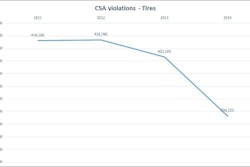By Robert Dieli, RDLB, Inc.
Once a month, usually on the first Friday, all eyes turn to the Bureau of Labor Statistics (BLS) as it releases its monthly Employment Situation Report.
Getting all the attention, often for the wrong reason, are the two headline figures. The first, from the Household Survey of employment, is the Unemployment Rate. The second, from the Establishment Survey of employment, is the change in total non-farm payroll employment. Contained within the latter is a statistic of considerable interest to readers of publications like this one: the level of truck transportation employment.
Not only is the level and trend of truck transportation employment one of the better indicators of current and prospective conditions in our industry, it also can provide some insight into the current and prospective condition of the economy. As long as we need trucks to move freight, we will need people to drive those trucks, service those trucks and schedule those trucks.
The truck transportation employment figures published by the BLS are based on a sample of firms in our industry that includes general freight (short and long haul as well as TL and LTL carriers), specialized freight (short and long haul) and moving companies.
According to the BLS, there are about 1,455,000 persons employed in the truck transportation category. Of those, about 61 percent were involved in general freight, about 21 percent in specialized freight, about 6 percent in moving and 12 percent were categorized as supervisory personnel.
Because the figures just published by the BLS for July are their first estimates of the level of employment, one should always be careful about how much to read into the “latest” news. Each batch of numbers goes through two revisions.
According to the latest release, total truck transportation employment was up by 4,700 persons in July.
This partially reversed the cumulative loss of 15,000 jobs that had occurred between February and May.
This is one of those cases where one wishes it did not take three months for the numbers to settle down.
Why?
Because we would like to be able to better figure out whether the recent softness in employment has been resolved or whether the July reading is just a momentary pause in the decline we have seen over most of 2016.
From what we have seen from the BLS so far in 2016, it appears that most of the recent softness has been concentrated in the specialized freight category. Employment in general freight, both TL and LTL, has remained firm. The July level of employment is about 10,000 persons below the high for this expansion that was set in January of 2016.
Some of that decline can be traced to lower freight volumes. And some of that decline can be traced to adjustments in trucking capacity. And some can be traced to the continued efforts of shippers to rebalance their supply chains.
We will be looking closely at the reports on employment and freight over the next several months to see how those issues are being resolved. We have found that looking at the two measures of industry activity together gives a better view of what is going on and what to expect.
Robert F. Dieli is president and founder of RDLB, Inc. an economic research and management consulting firm based in Lombard, Ill. Bob regularly collaborates with MacKay & Company on economic publications as well as industry presentations such as HDAD.











